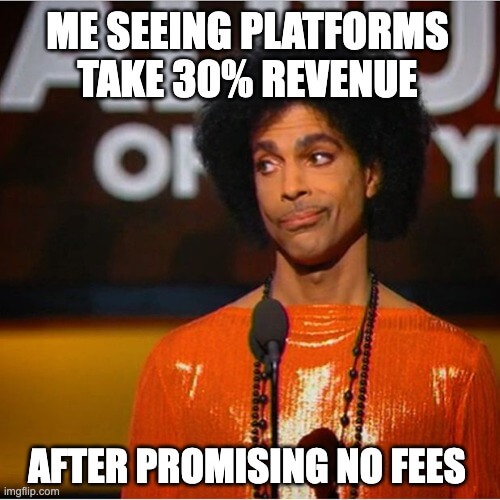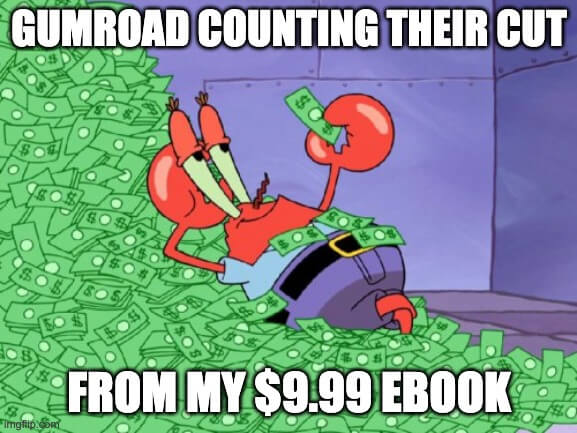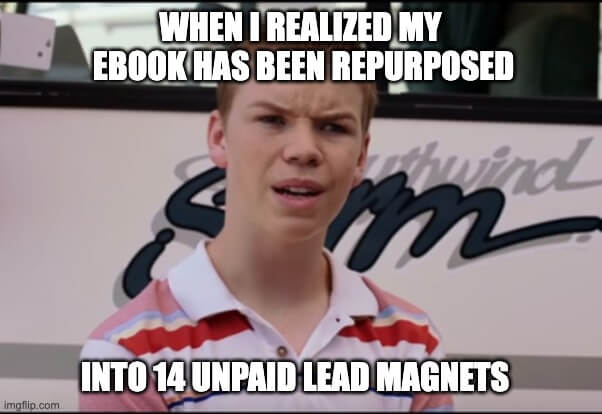If you want to jump straight to the 9 platforms, go here.
Selling ebooks isn’t just about writing — it’s also about where you sell.
Pick wrong, and you’ll lose money to fees or get lost in a crowded marketplace. Pick right, and you’ll turn readers into superfans.
68% of software users regretted their platform/software choice.

This blog post fixes that with 9 top platforms and strategies.
3 Things People Want in a Platform
1/ People want a platform that’s super quick and easy to use so they can start selling instantly (read: “treat me as a noob”).
2/ People want to keep as much of their revenue as possible, especially this being a digital product (read: “if possible, I want a platform/tool that’s free”).

3/ People don’t want their hard work stolen (read: “only paying customers can download my ebook, meaning the platform should protect my file and stop “pirates” from illegally downloading my ebook).
The 9 Best Platforms to Sell Ebooks
I’m assuming you’ve already nailed down the publishing process – whether that’s using self-publishing platforms like Amazon’s Kindle Direct Publishing or something else. Let’s jump in…
Category 1: Solo Creators Wanting a Simple Setup to Sell Instantly
1/ CartMango
Pricing:
0% transaction fees, $0 monthly/yearly fees during beta, valid through 2025.
The only fee you pay is Stripe / PayPal transaction fees which you pay directly to them.
Best For:
Testing ebook ideas fast or selling one-time guides.
Notable features:
People can buy your ebook instantly without “logging in” -> less hassle -> 45% more people finishing their purchases -> more sales.
PROTECTED, instant ebook delivery — meaning even if non-buyers know the ebook’s access link, they still won’t be able to access it -> less money loss due to piracy.
No waiting for payout — your funds go directly to your Stripe and/or PayPal account.
Customers can choose how they want to pay — via credit card or PayPal -> boosts sales.
100% human customer support — no AI bots pretending to understand you with lame questions.
Cons:
No subscriptions yet, currently only support one-time free pricing. Because it’s still in beta, there might be more bugs than established platforms.
Check out CartMango here.
2/ Gumroad
Pricing:
10% + $0.50 transaction fees on top of Stripe / PayPal fees.

Best For:
Folks who don’t want to pay a monthly recurring fee but are ok with paying higher transaction fees.
Notable Features:
Can also sell physical products apart from digital ones.
An established player with a strong brand.
More direct integrations with other tools without the need for “integrators” like Zapier and Make.
Cons:
Expensive fees (10% + $0.50) per transaction (e.g. If you sell a $30 ebook -> the fee is $3.50; If you sell a $100 ebook -> the fee is $10.50; The more expensive your ebook, the higher fees you pay).
Minimum payout of $10 (this means if you only sell an ebook at $9, you can’t get your money)
Need to wait for payout period to receive your funds (weekly but can also switch to monthly or quarterly).
AI bot customer support: Some users complain they can’t get support because the bot doesn’t understand what they want yet it doesn’t want to transfer to a human agent.
Check out Gumroad here.
Category 2: Mass Marketplaces (Huge Audiences, Fierce Competition)
3/ Amazon KDP (Kindle Direct Publishing)
Pricing:
0% upfront fees (free to publish).
Royalties: Up to 70% for ebooks priced between $2.99-$9.99 in eligible markets.
Best For:
Authors targeting mass audiences (fiction, non-fiction).
Leveraging Amazon’s global reach.
Enrolling in Kindle Unlimited (exclusivity required).
Notable Features:
Global distribution: Expanded to 12 new countries in 2025, including Vietnam and Chile.
Kindle Unlimited: Earn royalties based on page reads (exclusive to KDP Select).
Print-on-demand: Automatically sell paperbacks with no inventory.
AI-powered insights: New 2025 dashboard flags underperforming keywords/blurbs.
Pros:
Massive audience: 300+ million active Amazon shoppers.
High royalties: 70% rate in key markets (if priced correctly).
Free ISBN: Provided for paperbacks.
Cons:
Exclusivity: KDP Select locks you out of other ebook sales platforms (e.g., Apple Books).
No customer emails: Can’t retarget buyers or build a list.
Steep competition: 4 million+ titles published monthly.
Check out Amazon KDP here.
4/ PublishDrive
Pricing:
10% royalty cut on sales (no upfront fees).
Additional fees: $10/month for global print distribution (optional).
Best For:
Authors wanting global distribution (400+ stores).
Converting ebooks into audiobooks without upfront costs.
Targeting emerging markets (e.g., Nigeria, Vietnam).
Notable Features:
AI Audiobook Conversion: Auto-narrates ebooks using AI voices (15-minute setup).
One-click global distribution: Apple Books, OverDrive, 24Symbols, and 400+ others.
Emerging markets: 2025 expansion into 8 African countries via partnerships.
Real-time analytics: Track sales across all stores in one dashboard.
Pros:
No exclusivity: Sell everywhere simultaneously (unlike Amazon KDP).
Audiobook royalties: Earn 50% from AI-narrated audiobooks.
Tax automation: Handles VAT for EU/UK buyers.
Cons:
10% royalty cut: Higher than Amazon KDP’s 30% fee for similar reach.
Print costs: $10/month for paperback distribution to select stores.
No built-in storefront: Requires linking to external retailers.
Check out PublishDrive here.
Category 3: Community Hubs (For Influencers & Superfans)
5/ BlurBay
Pricing:
5% credit card processing fee + 5% BlurBay transaction fee on all sales.
Best For:
Beauty, fashion, and lifestyle influencers.
Creators with loyal, niche audiences (e.g., skincare enthusiasts, fitness coaches).
Selling bundled content (ebooks + video tutorials).
Notable Features:
Subscription libraries: Fans pay $10/month for unlimited access to your ebooks.
Community hub: Host polls, discussions, and Q&A sessions with subscribers.
Niche analytics: Track top-performing beauty/fashion keywords (e.g., “vegan hair care”).
TikTok/Instagram integration: Auto-post ebook teasers to Stories/Reels.
Pros:
Low competition: Curated for niche audiences (unlike Amazon’s overcrowded marketplace).
Recurring revenue: Subscriptions provide stable monthly income.
Built-in audience: 80% of users are women aged 18-34 interested in lifestyle content.
Cons:
Limited reach: Struggles to attract non-lifestyle niches (e.g., tech, finance).
No print/audio support: Digital ebooks only.
Basic marketing tools: Requires external tools for email campaigns.
Check out BlurBay here.
6/ Podia
Pricing:
$39/month (Mover plan, 5% transaction fees on top of Stripe/PayPal fees).
$89/month (Shaker plan, 0% transaction fees but still need to pay Stripe/PayPaypal fees, adds affiliate programs and analytics).
Best For:
Creators selling multiple products (ebooks + courses + memberships).
Building long-term communities around your content.
Beginners needing an all-in-one platform.
Notable Features:
All-in-one hub: Sell ebooks, courses, webinars, and memberships in one place.
Email marketing: Built-in campaigns and automations (no Mailchimp needed).
Community spaces: Host discussions, polls, and live chats for buyers.
2025 AI tools: Auto-generates course/ebook bundles based on buyer trends.
Pros:
Flat pricing: No per-transaction fees (unlike Gumroad’s 10% cut).
Unlimited products: Upload as many ebooks/courses as you want.
24/7 support: Live chat and email with <1-hour response time.
Cons:
Basic analytics: Lacks detailed sales funnel tracking (e.g., ad ROI).
No print/audiobooks: Digital products only.
Template limitations: Customizable storefronts but fewer themes than Shopify.
Check out Podia here.
Category 4: Socially Conscious Platforms (Supporting Indie Sellers)
7/ Bookshop
Pricing:
Indie Bookstores: Earn 100% profit on ebook sales if customers select their store. For non-specific purchases, 30% goes to a shared pool for all stores.
Authors/Retail Pricing:
Ebook prices are set by publishers, not authors/bookstores. Bookshop adjusts prices if wholesale discounts are <20%.
Authors earn 10% affiliate commissions on sales via their links.
Best For:
Authors: Self-published writers using Draft2Digital/IngramSpark can list ebooks, but no direct partnerships with stores.
Readers: Ethically minded buyers supporting local stores.
Notable Features:
100% Profit Sharing: True only if buyers choose a store. Otherwise, 30% shared.
DRM Compliance: Most ebooks have DRM; exceptions noted as “DRM-free”.
App/Web Access: iOS/Android apps + browser access.
Pros:
Ethical Appeal: Attracts buyers wanting to support indie stores.
No Exclusivity: Sell on other ecommerce platforms simultaneously.
Global Access: Available via app/web, but limited to US/UK markets.
Cons:
Limited Control: Pricing influenced by publisher/wholesale terms, not bookstores.
Niche Audience: Smaller reach than Amazon/Apple Books.
Check out Bookshop here.
Category 5: Gig Economy Marketplaces (Built-In Audiences)
8/ Fiverr
Pricing:
20% transaction fee (no listing costs).
Best For:
Authors needing instant visibility (80M+ monthly users).
Selling short, niche ebooks (e.g., “30-Minute SEO Guides”).
Notable Features:
Gig listings: Promote ebooks as “services” (e.g., “I’ll write a finance ebook”).
Built-in audience: Tap into Fiverr’s global buyer base.
Seller dashboard: Manage orders, messages, and reviews.
Pros:
Traffic advantage: No need to drive external traffic.
Upsell potential: Bundle ebooks with coaching/editing services.
Cons:
Manual delivery: Must email ebooks after each sale.
High competition: Thousands of similar listings.
Check out Fiverr here.
Category 6: High-Touch Author Services (Premium Support)
9/ Draft2Digital
Pricing:
10% royalty cut (no upfront fees).
Best For:
Authors with 5+ titles seeking hands-off distribution.
Leveraging library sales for passive income.
Perks:
Promo scheduling: Auto-discounts/price changes (e.g., “Pre-order at 50% off”).
Library distribution: Get ebooks into 30,000+ libraries (e.g., OverDrive).
Key Difference:
Not really a platform to sell ebooks, but more of a service.
Strategic Recommendations
Use CartMango for quick launches and testing (speed, zero fees)
Pair with PublishDrive/Draft2Digital for global/library distribution.
Check out Draft2Digital here.
Repurposing Content: Turn 1 eBook into 15 Assets

Why Bother Repurposing?
The above meme is from someone who doesn’t understand “content leverage”.
The reality is reusing content saves time and reaches new audiences. A $15 ebook can become free blog posts (for leads), YouTube scripts (for views), and audiobooks (for Spotify listeners).
Think of your ebook as raw material – like turning flour into bread, pancakes, and cookies.
Part 1: Text-Based Repurposing
1/ Blog Series
Split chapters into standalone posts. A 10-chapter ebook becomes 10 weeks of blog content.
Example:
Chapter 3 -> 5 Time Management Hacks for Remote Workers
Chapter 7 -> Why Multitasking Ruins Productivity
Use Designrr to auto-convert ebook PDFs into blog-ready text.
2/ Social Media Carousels
Turn statistics or quotes into swipeable posts. Instagram carousels get 3x more shares than single images.
Steps:
Screenshot a key ebook page
Add text overlay in Canva
Post with “Swipe to learn [benefit]”
Example: “Swipe to see why 72% of creators fail at ebook marketing → [Link in bio]”.
3/ Email Courses
Convert chapters into 5-day email courses. Offer it as a freebie to grow your list.
Template:
Day 1: Chapter 1 summary + 1 actionable tip
Day 3: Chapter 3 case study + downloadable checklist
Day 5: “Get the full ebook” CTA
BirdSend’s automation tools can schedule and send these emails.
4/ Quizzes
Turn “how-to” chapters into interactive quizzes. People love testing their knowledge.
E.g.
“What’s Your Productivity Personality?
→ Take the quiz to get a free chapter!”
Tools: Interact Quiz Builder.
5/ Medium/LinkedIn Articles
Rewrite chapters as opinion pieces. Add personal stories to make them relatable.
Tip: Use Hemingway Editor to simplify complex sentences for social media audiences.
Part 2: Audio & Visual Repurposing
6/ Audiobooks
Convert your ebook into an audiobook in 15 minutes using AI. Upload it to:
Spotify (as a podcast)
Apple Books (as paid audiobooks)
YouTube (as background audio with subtitles)
Example: End each episode with: “Get the ebook with diagrams at [link].”
7/ YouTube Scripts
Turn chapters into video scripts. Film yourself explaining key concepts.
You can use a structure like this:
Hook: “72% of creators make this ebook mistake!”
Lesson: Explain one chapter visually
CTA: “Download the ebook to learn [X]”
Tools: Kapwing adds auto-captions for silent viewers.
8/ Pinterest Infographics
Convert data-heavy sections into pin-friendly graphics.
Example:
5 Steps to Write an eBook in 2025 (vertical infographic)
Ebook Pricing Mistakes (comparison chart)
Tools: Use Canva’s ebook template pack.
9/ Webinar Slides
Use chapters as webinar content. Offer live Q&A to boost engagement.
Promo Strategy:
Share 3 webinar slides on LinkedIn → “Full deck in the ebook”
Replay the webinar as a YouTube video.
10/ Course Modules
Expand chapters into paid online courses. Sell them on CartMango alongside your ebook.
E.g.
Ebook: Social Media Marketing 101
Course: Advanced TikTok Ads Masterclass
Part 3: Advanced Repurposing
11/ Chatbot Content
Feed ebook content into an AI chatbot. Let visitors ask questions and get instant answers. You’ll save a lot of time and energy this way.
12/ Physical Workbooks
Convert exercises into printable PDFs. Sell them as upsells or give away as free lead magnets.
Design Tip:
Use redacted ebook pages as workbook examples.
13/ Twitter/X Threads
Break chapters into tweetstorms to attract people who’re more inclined to learn more.
Example:
“10 Lessons from Writing My First eBook ↓
1. Lesson 1: [Key point]
2. Lesson 2: [Key point]
…
10. Get the full ebook here: [link]”
14/ Multiple Languages
Use AI tools to convert your ebook into Spanish, French, etc. Target new markets without rewriting.
Warning: Always hire human editors to fix AI translation errors and make the flow smoother.
15/ Membership Content
Add repurposed content to a paid membership site. You can also drip-release it monthly.
Example:
Month 1: Audiobook access
Month 2: Video course
Month 3: Live Q&A
Part 4: Measuring Success
Track what resonates using:
Google Analytics: See which repurposed content drives ebook sales
Bitly: Compare link clicks across platforms
Heatmaps: Tools like Hotjar show which PDF pages readers highlight
Double down on formats that convert. If audiobook listeners buy 2x more, create more audio content.
Action Checklist
Pick 3 repurposing methods to try this week
Set up tracking links for each format
Schedule content across 2-3 platforms
Selling Ebooks Online Strategies
Start With a Plan
Before launching your ebook, build a simple marketing plan. Focus on platforms where your readers already hang out. For example, fiction authors thrive on TikTok (#BookTok), while business writers thrive on LinkedIn. Use free tools like Google Trends to spot popular keywords in your niche.
A basic plan should include:
Launch date: Pick a specific day to build hype.
Promo channels: Choose 2-3 platforms (e.g., Instagram + email).
Budget: Allocate funds for ads or collaborations.
Social Media That Converts
Social media isn’t just about posting – it’s about strategic posting. Share bite-sized ebook snippets, like a juicy quote or a helpful tip. Use Canva to turn text into eye-catching graphics.
For example:
Post “How-to” reels showing your ebook’s value.
Run polls asking followers which chapter excites them most.
Pin a “Coming Soon” banner to your profile.
TikTok and Instagram stories work best for visual teases. Link these posts to a landing page where readers can pre-order or download a free chapter in exchange for their email address.
Team Up With Micro-Influencers
Partner with creators who have 1k-10k engaged followers in your niche. Offer them 50% of sales they generate or a free ebook copy for honest reviews.
E.g.
A fitness influencer can promote your diet ebook to their subscribers.
A bookstagrammer can share a photo review with a discount code.
Tools like Booksprout simplify influencer outreach by connecting you with reviewers. Always check an influencer’s engagement rate before partnering.
Email Lists = Golden Tickets
Collect emails early by offering a free chapter or checklist. Tools like BirdSend let you automate welcome emails with download links.
Once you have a list:
Send weekly tips related to your ebook’s topic.
Share behind-the-scenes stories about writing the book.
Announce flash sales exclusively to subscribers.
SEO: Get Found for Free
Optimize your ebook’s sales page for Google searches. Include keywords like “best [topic] ebook 2025” in titles and descriptions. Listing your ebook in the Google Play Store could help rank higher in search results too.
For example, if your ebook covers productivity:
Title: “Time Management Mastery: 2025’s Top Productivity Guide”
Keywords: “time management tips,” “productivity ebook”.
Add a FAQ section answering questions like “How long is the ebook?” to rank for common questions.
Free Giveaways Build Buzz
Offer limited-time free downloads to spark word-of-mouth. Share the offer in Facebook groups or Reddit communities related to your topic.
Example:
“Download Chapter 1 free this week – reply with feedback”
Gift 10 free copies to engaged followers who tag friends.
Paid Ads That Don’t Break the Bank
Start with $5/day Facebook/Google ads targeting specific interests.
Test different ad types:
Video ads: Film a 30-second ebook summary.
Carousel ads: Show the table of contents + reviews.
Turn Readers into Affiliates
Create a referral program where buyers earn 40-50% commission on sales they drive.
E.g.
“Share your unique link – earn $5 per sale”
Offer bonuses for top affiliates (e.g. a free coaching call).
Repurpose Content Everywhere
Reuse ebook material across formats:
Blog posts: Expand a chapter into a long-form article.
Podcasts: Discuss key lessons in interviews.
Audiobooks: Use Lovo AI to convert text to audio.
Track What Works
Use free tools to monitor progress:
Google Analytics: Track website visitors from ads/social.
Bitly: Shorten links to see which platforms drive clicks.
Hotjar: Watch recordings of how people navigate your sales page.
Adjust strategies monthly. For example, if email is your best channel for getting sales (most likely), then double down on it.
Tips for More Revenue
1/ The Bonus Bundle
Instead of a $15 ebook, sell a $27 bundle with:
Your ebook
10 Canva templates (e.g., social media post layouts)
A 30-minute “author commentary” audio (can record via AI if you don’t care about building a personal brand).
You can do this via CartMango‘s 1-click order bump feature.
2/ Micro-Influencer Collabs
Partner with 5k-10k follower TikTok/Instagram/YouTube creators. Or with a follower count that makes sense for your business.
They get 50% of the sales revenue. You exposure and a customer list which you can market to in the future.

TL;DR – Platforms to Sell Ebooks
Choosing the right platform to sell your ebook is about balancing ease, revenue, and security.
Platforms like CartMango (zero fees, instant payouts) excel for quick testing, while Amazon KDP (70% royalties, global reach) works for mass audiences. Niche creators might prefer BlurBay for lifestyle-focused communities or Bookshop for socially conscious sales.
Repurposing your ebook unlocks its full potential.
Turn chapters into blog posts, social carousels, or email courses to reach audiences who prefer bite-sized content. Audiobooks (via AI tools) and YouTube scripts expand your reach, while quizzes and infographics make learning interactive.
Marketing requires strategy, not luck.
Build hype with free chapters, collaborate with micro-influencers (50% revenue share), and use email lists for flash sales. Optimize titles for SEO (“Best [Topic] Ebook 2025”) and run low-budget ads targeting specific reader interests.
Track results rigorously. Use Google Analytics for traffic sources, Bitly for link performance, and Hotjar to see which ebook sections resonate. Double down on formats that drive sales—if audiobook listeners buy more, prioritize audio content.
Final Tips for Success
– Bundle smartly: Pair ebooks with templates or bonus audio for higher pricing.
– Go global: Use AI translation (with human edits) to tap new markets.
– Protect your work: Choose platforms with anti-piracy features like CartMango’s link protection.
Your ebook isn’t just a product—it’s a toolkit for building authority, income, and reader loyalty.
FAQs
1/ Which platform lets me test ebook ideas without upfront fees?
CartMango’s zero-fee beta (through at least 2025) is ideal for quick launches. You keep 100% revenue minus Stripe/PayPal fees, get instant payouts, and anti-piracy link protection. For mass reach, Amazon KDP offers 70% royalties but locks you into exclusivity. Niche creators should try BlurBay for lifestyle audiences or Bookshop for indie store partnerships.
2/ How do I repurpose a 10-chapter ebook without burning out?
Turn chapters into 10 blog posts (one per week), 5 TikTok scripts highlighting stats, and an AI-narrated audiobook. Use tools like Canva for Instagram carousels and Lovo AI for voiceovers. Track which formats drive sales via Google Analytics – double down on what works.
3/ Can I market my ebook with a $0 budget?
Yes. Share free chapters in niche Facebook groups, collaborate with micro-influencers for revenue splits (50/50), and run flash sales via your email list. Repurpose quotes into Pinterest infographics – they keep driving traffic months later.
4/ How do I stop pirates from stealing my ebook?
Use platforms with built-in security: CartMango’s link protection blocks non-buyers, even if they have the URL. Add watermarks to PDFs and release “updated editions” yearly to outdate leaked copies.
5/ Should I price my ebook at $9.99 or $49?
Depends on depth. Short guides ($5-$15) work for impulse buys, while niche playbooks ($30-$50) justify premium pricing if bundled with templates or audio commentary. Test tiered pricing: $19 ebook-only vs. $49 bundle (ebook + video course + ChatGPT prompts).
Related
- Podia vs Gumroad: The Recurring Revenue Handcuffs (2026)
- SendOwl vs Gumroad: The Recurring Revenue Black Hole (2026)
- Gumroad vs Sellfy: The Vendor Lock-in Cage (2025)
- Gumroad vs Payhip: The Hidden Trap for Creators (2025)
- ThriveCart vs SamCart – The Subscription Hostage Trap (2025)
- 8 ThriveCart Alternatives & The Lifetime Pricing Paradox (2025)
- 8 SamCart alternatives + Subscription hostage (2025)
- The GENTLE Method: Soft marketing for creators
- How Far in Advance Should You Promote a Webinar?
- The SAVINGS Method: The Productivity Improvement Plan for Creators
